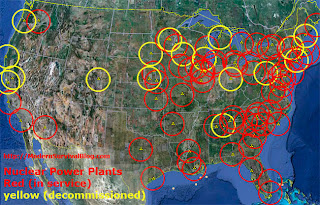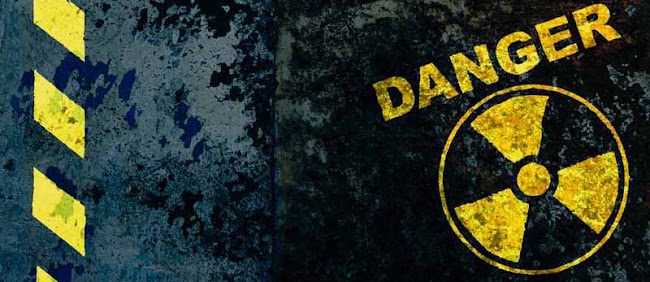The explanation of what could happen in this scenario is quite long but this article explains it extremely well using Japan's nuclear crisis caused by the earthquake of 2011.
How Japan's Nuclear Crisis Works
Commercial nuclear reactors are a fact of life in many parts of the developed world. Because they do make use of a radioactive fuel source, these reactors are designed and built to the highest standards of the engineering profession, with the perceived ability to handle nearly anything that nature or mankind can dish out. Earthquakes? No problem. Hurricanes? No problem. Direct strikes by jumbo jets? No problem. Terrorist attacks? No problem. Strength is built in, and layers of redundancy are meant to handle any operational abnormality.Shortly after an earthquake hit Japan on March 11, 2011, however, those perceptions of safety began rapidly changing. Explosions rocked several different reactors in Japan, even though initial reports indicated that there were no problems from the quake itself. Fires broke out at the Onagawa plant, and there were explosions at the Fukushima Daiichi plant.
So what went wrong? How can such well-designed, highly redundant systems fail so catastrophically? Let's take a look.
Understanding a Nuclear Reactor
At a high level, these plants are quite simple. Nuclear fuel, which in modern commercial nuclear power plants comes in the form of enriched uranium, naturally produces heat as uranium atoms split. The heat is used to boil water and produce steam. The steam drives a steam turbine, which spins a generator to create electricity. These plants are large and generally able to produce something on the order of a gigawatt of electricity at full power.In order for the output of a nuclear power plant to be adjustable, the uranium fuel is formed into pellets approximately the size of a Tootsie Roll. These pellets are stacked end-on-end in long metal tubes called fuel rods. The rods are arranged into bundles, and bundles are arranged in the core of the reactor. Control rods fit between the fuel rods and are able to absorb neutrons. If the control rods are fully inserted into the core, the reactor is said to be shut down. The uranium will produce the lowest amount of heat possible (but will still produce heat). If the control rods are pulled out of the core as far as possible, the core produces its maximum heat. Think about the heat produced by a 100-watt incandescent light bulb. These bulbs get quite hot -- hot enough to bake a cupcake in an Easy Bake oven. Now imagine a 1,000,000,000-watt light bulb. That is the kind of heat coming out of a reactor core at full power.
The reactors that failed in Japan are Mark 1 boiling water reactors designed by General Electric in the 1960s. This is one of the earlier reactor designs, in which the uranium fuel boils water that directly drives the steam turbine. This design was later replaced by pressurized water reactors because of safety concerns surrounding the Mark 1 design. As we have seen, those safety concerns turned into safety failures in Japan. Let's take a look at the fatal flaw that led to disaster.
The Fatal Flaw in Boiling Water Nuclear Reactors
A boiling water reactor has an Achilles heel -- a fatal flaw -- that is invisible under normal operating conditions and most failure scenarios. The flaw has to do with the cooling system.A boiling water reactor boils water: That's obvious and simple enough. It's a technology that goes back more than a century to the earliest steam engines. As the water boils, it creates a huge amount of pressure -- the pressure that will be used to spin the steam turbine. The boiling water also keeps the reactor core at a safe temperature. When it exits the steam turbine, the steam is cooled and condensed to be reused over and over again in a closed loop. The water is recirculated through the system with electric pumps.
The design's vulnerability comes into play if the electric pumps lose power. Without a fresh supply of water in the boiler, the water continues boiling off, and the water level starts falling. If enough water boils off, the fuel rods are exposed and they overheat. At some point, even with the control rods fully inserted, there is enough heat to melt the nuclear fuel. This is where the term meltdown comes from. Tons of melting uranium flows to the bottom of the pressure vessel. At that point, it's catastrophic. In the worst case, the molten fuel penetrates the pressure vessel and gets released into the environment.
Because of this known vulnerability, there is huge redundancy around the pumps and their supply of electricity. There are several sets of redundant pumps, and there are redundant power supplies. Power can come from the power grid. If that fails, there are several layers of backup diesel generators. If they fail, there is a backup battery system. With all of this redundancy, it seems like the vulnerability is completely covered. There is no way for the fatal flaw to ever be exposed.
Unfortunately, shortly after the earthquake, the worst-case scenario unfolded.
The Worst-case Scenario in Japan's Nuclear Crisis
The nuclear power plants in Japan weathered the earthquake itself without difficulty. The four plants nearest the quake's epicenter shut down automatically, meaning that the control rods were fully inserted into their reactor cores and the plants stopped producing power (This couldn't have happened in Revolution since there wasn't any kind of power to do it). That isn't a problem because the plant could get power from the power grid to run the pumps.However, the power grid became unstable and it shut down as well. That brought the backup diesel generators to generate electricity.
But then the tsunami hit. And unfortunately, the tsunami was far larger than anyone had planned for. If the backup diesel generators had been higher off the ground, designed to run while submerged in water or protected from deep water in some way, the crisis could have been averted. Unfortunately, the unexpected water levels from the tsunami caused the generators to fail.
This left the last layer of redundancy -- batteries -- to operate the pumps. The batteries performed as expected, but they were sized to last for only a few hours.
Although operators did truck in new generators, they could not be hooked up in time, and the coolant pumps ran out of electricity. The fatal flaw in the boiling water design had become exposed. With it exposed, the next step in the process led to catastrophe.
Explosions at Japan's Nuclear Power Plants
With the batteries dead, the coolant pumps failed. With no fresh coolant flowing into the reactor core, the water that kept it cool began boiling off. As the water boiled away, the tops of the fuel rods were exposed, and the metal tubes holding the uranium fuel pellets overheated and cracked. The cracks allowed water to enter the tubes and get to the fuel pellets, where it began generating hydrogen gas. The process is called thermolysis -- if you get water hot enough, it breaks down into its constituent hydrogen and oxygen atoms.Hydrogen is a highly explosive gas -- recall the Hindenburg explosion, in which the Hindenburg was full of hydrogen gas. In Japan's nuclear plants, pressure from the hydrogen built up, and the gas had to be vented. Unfortunately, so much hydrogen was vented so quickly that it exploded inside the reactor building. This same chain of events unfolded in several different reactors.
The nuclear incidents in Japan are described as Level 6 INES events (International Nuclear and Radiological Event Scale). Three Mile Island was a Level 5 event. Chernobyl was a Level 7 event, and that is the top of the event scale. Obviously, it's a serious situation.
In the scenario depicted in Revolution, every form of electricity stops working instantly and there wouldn't be time for the control rods to be incerted in the core. In this case every nuclear plant would undergo into Level 7 events, meaning powerful steam explosions releasing significant fraction of core material into the environment, resulting in tens or even hundreds of instant deaths, and tens of thousands more dying of cancer over the next years.
 There are 104 Nuclear Power Plants (NPP) in the US. In the map (click on it to enlarge) you can see all NPP in the US and the affected area in case of accident. As you can see, most of the NPP are in the Monroe Republic and the Georgia Federation.
There are 104 Nuclear Power Plants (NPP) in the US. In the map (click on it to enlarge) you can see all NPP in the US and the affected area in case of accident. As you can see, most of the NPP are in the Monroe Republic and the Georgia Federation.There is no doubt that this would be a major problem in a post-Blackout world. We don't know if the show will address this problem in this season or any other to come, but it would defenetly add some realism to the story. Maybe they could show some abandoned regions with "radioactive zone" signs, or something like that.
What do you think of this? Is Revolution going to show some of this radioactive zones in the future, maybe in the Georgia Federation? Leave your comments below!
Sources: HowStuffWorks | Wikipedia 1 | Wikipedia 2


